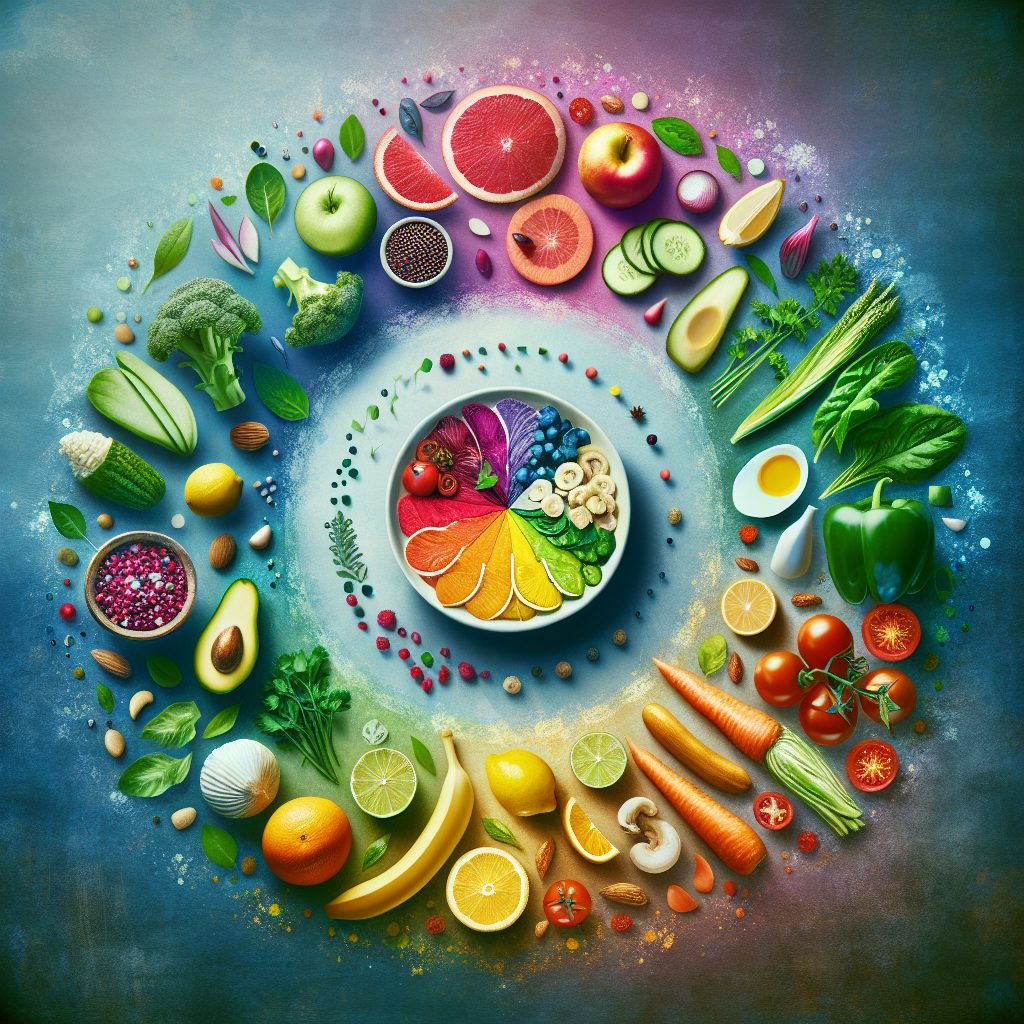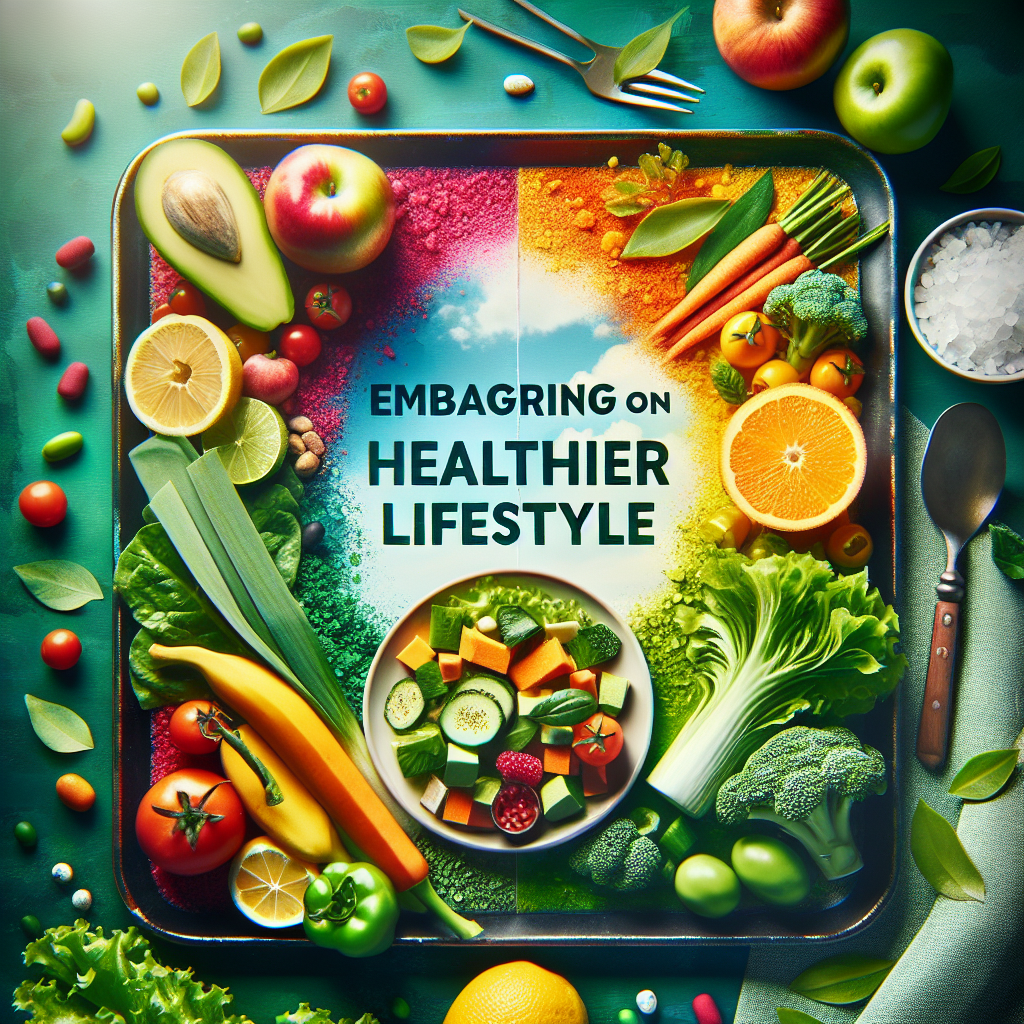Congratulations on taking the first step towards a healthier lifestyle! In this article, we will guide you through what to expect during your first week of eating healthy. From changes in your energy levels to potential cravings and even surprising mood swings, we’ll help you navigate the ups and downs of this transformative journey. So sit back, relax, and get ready to embrace a new and improved version of yourself as you embark on this exciting adventure of nourishing your body and mind.
Understanding the Importance of a Healthy Diet
The Benefits of Eating Healthy
Eating a healthy diet is not just about losing weight or looking good; it is about nourishing your body and providing it with the essential nutrients it needs to function properly. A balanced diet, consisting of a variety of fruits, vegetables, whole grains, lean proteins, and healthy fats, has numerous benefits for your overall well-being.
A healthy diet can boost your immune system, helping you fight off illnesses and diseases. It can also improve your energy levels, allowing you to be more productive and active throughout the day. Additionally, a well-balanced diet can enhance your mood and cognitive function, improving your mental well-being.
The Impact of a Poor Diet on Health
On the other hand, a poor diet can have detrimental effects on your health. Consuming excessive amounts of processed foods, sugary drinks, and unhealthy fats can lead to weight gain and increase your risk of developing chronic conditions such as obesity, diabetes, heart disease, and certain types of cancer.
A poor diet can also negatively affect your digestion, causing gastrointestinal issues like constipation and bloating. It can weaken your bones and muscles, leaving you more susceptible to injuries. Furthermore, an unhealthy diet can impair your sleep patterns, leaving you feeling tired and groggy throughout the day.
Common Misconceptions about Healthy Eating
There are several misconceptions surrounding healthy eating that can often deter people from adopting a nutritious diet. One common misconception is that healthy food is tasteless and boring. However, with the right ingredients and cooking techniques, healthy meals can be incredibly flavorful and satisfying.
Another myth is that eating healthy is expensive. While some organic or specialty products may come at a higher price, there are plenty of affordable options available. By focusing on fresh produce, whole grains, and lean protein sources, you can create nutritious meals without breaking the bank.
It’s also important to debunk the notion that healthy eating requires strict restrictions and eliminating all indulgences. In reality, moderation is key. It’s perfectly fine to enjoy your favorite treats occasionally as part of a well-rounded diet. The key is finding a balance that works for you and prioritizing nutrient-dense foods.
Preparing for a Healthy Eating Plan

Setting Realistic Goals
Before embarking on a healthy eating plan, it’s important to set realistic goals that align with your individual needs and circumstances. Make sure your goals are specific, measurable, attainable, relevant, and time-bound (SMART). This will help you stay motivated and track your progress effectively.
For example, rather than simply aiming to “eat healthier,” you could set a goal to incorporate at least two servings of vegetables into each meal, drink eight glasses of water daily, or limit your intake of sugary snacks to once a week. These goals are specific, measurable, and achievable, making it easier for you to stay on track.
Creating a Meal Plan
Meal planning is a powerful tool that can set you up for success on your healthy eating journey. It involves deciding what meals and snacks you will have in advance, creating a shopping list, and mapping out your food preparations for the week. With a well-thought-out meal plan, you can ensure that you have nutritious options readily available and minimize the likelihood of making impulsive, unhealthy choices.
When creating your meal plan, aim for a good balance of macronutrients (carbohydrates, proteins, and fats) and include a variety of fruits, vegetables, whole grains, lean meats, fish, legumes, and healthy fats. Consider your schedule and lifestyle to determine how many meals and snacks you will need per day and allocate time for cooking and meal prepping.
Making a Grocery List
Once you have your meal plan set, it’s time to make a grocery list. Having a well-organized and comprehensive grocery list can save you time and prevent you from purchasing unnecessary items. Start by reviewing your meal plan and noting down all the ingredients you will need.
When it comes to shopping for healthy foods, prioritize fresh produce such as fruits and vegetables. Opt for whole grains like brown rice, quinoa, and whole wheat bread. Include lean proteins such as skinless chicken, turkey, fish, tofu, and legumes. Don’t forget to add healthy fats like avocados, nuts, and olive oil to your list. Lastly, make sure to have some healthy snacks like Greek yogurt, nuts, or fresh fruit on hand for those moments of cravings or hunger between meals.
Stocking Your Kitchen with Healthy Foods

Essential Nutrients for a Well-Balanced Diet
To maintain a healthy diet, it’s important to make sure your kitchen is stocked with nutritious foods that provide the essential nutrients your body needs. These nutrients include carbohydrates, proteins, healthy fats, vitamins, and minerals.
Carbohydrates, found in foods like fruits, vegetables, and whole grains, are the body’s main source of energy. Proteins, found in sources such as meat, fish, eggs, and legumes, are crucial for building and repairing body tissues. Healthy fats, found in avocados, nuts, seeds, and oily fish, are important for brain health, hormone production, and absorption of certain vitamins.
Vitamins and minerals, which are present in various fruits, vegetables, and whole foods, play a vital role in maintaining optimal health. They support immune function, promote healthy bone structure, aid in digestion, and have numerous other benefits for various bodily functions.
Filling Your Pantry with Healthy Staples
Having a well-stocked pantry can make healthy eating more convenient and accessible. Consider adding the following staples to your kitchen pantry:
- Whole grains: Brown rice, quinoa, whole wheat pasta, oats, and whole grain cereal.
- Canned goods: Low-sodium beans, lentils, canned tuna or salmon (in water), and canned vegetables (preferably low-sodium).
- Healthy oils: Olive oil, coconut oil, and avocado oil.
- Nuts and seeds: Almonds, walnuts, chia seeds, flaxseeds, and pumpkin seeds.
- Spices and herbs: A variety of spices and herbs, such as turmeric, cinnamon, paprika, basil, and oregano, to add flavor to your dishes without relying on excessive amounts of salt.
- Nut butter: Natural peanut butter, almond butter, or other nut spreads without added sugars or oils.
- Vinegars: Apple cider vinegar, balsamic vinegar, and red wine vinegar for dressings and marinades.
- Low-sodium broth or stock: Vegetable or chicken broth to use as a base for soups and stews.
Choosing Nutrient-Dense Ingredients
When stocking your kitchen with healthy foods, prioritize nutrient-dense ingredients. These are foods that provide a high amount of essential nutrients relative to their calorie content. Including nutrient-dense ingredients in your meals ensures that you are maximizing the nutritional value of each bite.
Some nutrient-dense ingredients to consider adding to your shopping list include leafy greens (spinach, kale, Swiss chard), colorful vegetables (bell peppers, broccoli, carrots), lean proteins (chicken breast, turkey, fish), whole grains (brown rice, quinoa, oats), and healthy fats (avocado, nuts, olive oil). These ingredients will not only contribute to a well-balanced diet but also enhance the taste and texture of your meals.
Overcoming Challenges and Cravings

Dealing with Withdrawal Symptoms
As you transition to a healthier diet, you may experience withdrawal symptoms if you were previously consuming high amounts of sugar, caffeine, or processed foods. These symptoms can include headaches, irritability, fatigue, and cravings. It’s important to remember that these symptoms are temporary and will subside as your body adjusts to the new dietary changes.
To manage withdrawal symptoms, ensure you are adequately hydrated, as dehydration can exacerbate symptoms like headaches. Gradually reduce your intake of stimulants like caffeine instead of quitting cold turkey. Opt for healthier alternatives to satisfy your cravings, such as fresh fruits when craving sweets or herbal tea when craving a warm beverage. Over time, your body will adapt to the healthier choices, and the cravings and withdrawal symptoms will diminish.
Addressing Emotional Eating
Emotional eating is a common challenge that many individuals face. It involves turning to food for comfort, stress relief, or distraction rather than in response to physical hunger. To overcome emotional eating, it’s important to develop alternative coping strategies that do not involve food.
Identify your triggers and emotional state when you find yourself reaching for food. Is it stress, boredom, sadness, or anxiety? Once you’ve identified the emotions driving your eating habits, find healthy alternatives to address those emotions. Engage in activities you enjoy, such as exercising, reading, listening to music, or practicing mindfulness and deep breathing exercises. Find a support system of friends or family members to talk to when you need emotional support.
Finding Healthy Alternatives to Cravings
Cravings for unhealthy foods are common, but there are healthier alternatives that can satisfy those cravings while still supporting your overall health goals. For example, if you are craving something sweet, reach for a piece of dark chocolate or fresh fruit instead of sugary desserts. If you’re craving something savory and crunchy, try air-popped popcorn or roasted chickpeas instead of potato chips.
Experiment with healthier versions of your favorite dishes by substituting unhealthy ingredients with nutritious alternatives. For instance, use zucchini noodles or spaghetti squash instead of pasta, or opt for baked sweet potato fries instead of regular fries. The key is to find satisfying, healthier alternatives that still provide the flavors and textures you enjoy.
Navigating the Healthy Options at Restaurants

Researching and Choosing Healthy Restaurants
When dining out, it’s important to research and choose restaurants that offer healthy options. Many restaurants now provide menus and nutritional information online, allowing you to make informed choices before visiting. Look for restaurants that prioritize whole, fresh, and locally sourced ingredients in their dishes.
Additionally, try to find restaurants that offer a variety of menu options, including vegetarian, vegan, and gluten-free options. This ensures that everyone in your party can find something that suits their dietary needs and preferences.
Making Wise Menu Choices
Once you are at the restaurant, make wise menu choices to ensure you stay on track with your healthy eating plan. Opt for dishes that are grilled, baked, steamed, or roasted instead of fried or crispy. Choose salads or veggie-based dishes as your main course and ask for dressings and sauces on the side to control portion sizes.
Pay attention to portion sizes and consider sharing a dish with a friend or taking leftovers home for another meal. Avoid ordering sugary drinks or alcoholic beverages, and opt for water or unsweetened iced tea instead.
Tips for Eating Out without Derailing Progress
Eating out doesn’t have to derail your healthy eating progress. Here are a few tips to help you make healthier choices and stay on track:
- Plan ahead: Look up the restaurant’s menu online and choose the healthiest options before arriving.
- Control portions: Ask for a half portion or request a to-go box right away and divide your meal in half before starting to eat.
- Mindful eating: Take your time to savor each bite, chew slowly, and listen to your body’s fullness cues to prevent overeating.
- Modify dishes: Ask for changes or substitutions to make your meal healthier, such as swapping fries for a side salad or requesting grilled options instead of fried.
- Be aware of hidden ingredients: Ask about the cooking methods, ingredients, and sauces used to ensure they align with your dietary goals.
- Avoid all-you-can-eat buffets: These can encourage overeating and make it difficult to control portion sizes.
Remember, one meal at a restaurant will not make or break your healthy eating plan. Focus on making the best choices available to you and enjoy the dining experience in moderation.
Meal Prepping and Cooking at Home

Benefits of Meal Prepping
Meal prepping involves preparing meals or ingredients in advance, typically for the upcoming week. This practice offers numerous benefits for those striving to maintain a healthy diet:
- Saves time: By spending a designated amount of time each week prepping meals, you can save time during busy weekdays when cooking from scratch can be more time-consuming.
- Reduces stress: Knowing that your meals are prepared in advance eliminates the stress of figuring out what to cook each day.
- Maintains portion control: By pre-portioning meals, you can control how much you eat, preventing overeating or reaching for unhealthy options when hunger strikes.
- Saves money: Meal prepping can help reduce food waste and save money by allowing you to utilize ingredients efficiently and avoid impulsive takeout or restaurant meals.
- Supports healthy choices: When you have healthy meals readily available in your fridge, you are more likely to reach for those options rather than opting for unhealthy convenience foods.
Effective Meal Planning Strategies
To optimize your meal prepping and ensure a successful week of healthy eating, consider the following strategies:
- Choose recipes and meals that can be prepped in advance and easily stored.
- Batch cook ingredients like grains, proteins, and vegetables that can be used in multiple dishes throughout the week.
- Invest in quality food containers that are sealable and microwave-safe to store your prepped meals.
- Label your containers with the name of the dish and the date it was prepared to keep track of freshness.
- Schedule a specific time each week to dedicate to meal prepping to establish it as a routine.
- Consider freezer-friendly meals that can be prepared in large quantities and frozen for later use on busy days.
By incorporating these strategies, you can streamline your meal prepping process, making it more efficient and enjoyable.
Easy and Nutritious Recipe Ideas
When prepping meals, it’s important to choose recipes that are both nutritious and appealing. Here are a few easy and nutritious recipe ideas to get you started:
- Quinoa Salad with Roasted Vegetables: Cook a batch of quinoa and roast a variety of vegetables, such as bell peppers, zucchini, and broccoli. Combine them in a bowl with a simple vinaigrette dressing for a delicious and filling salad.
- Sheet Pan Chicken and Vegetables: Place seasoned chicken breast and a medley of vegetables, such as Brussels sprouts, sweet potatoes, and cherry tomatoes, on a sheet pan. Roast in the oven until cooked through and enjoy a flavorful and balanced meal.
- Overnight Chia Pudding: In a jar, combine chia seeds, milk (dairy or plant-based), and a sweetener of your choice. Let it sit in the fridge overnight, and in the morning, you’ll have a nutritious and convenient breakfast option.
- Stir-Fry with Brown Rice: Prepare a stir-fry using a combination of colorful vegetables, lean protein (such as chicken, tofu, or shrimp), and a flavorful sauce. Serve it over brown rice for a wholesome and satisfying meal.
- Mason Jar Salads: Layer your favorite vegetables, proteins, and dressings in mason jars for ready-to-go salads that can be easily transported to work or enjoyed as a quick meal at home.
- Slow Cooker Chicken Chili: Combine chicken breast, beans, tomatoes, and spices in a slow cooker. Let it cook on low heat for several hours, and you’ll have a hearty and flavorful chili to enjoy throughout the week.
These are just a few examples of the endless possibilities when it comes to meal prepping. Get creative and experiment with different ingredients and flavors to keep your meals exciting and enjoyable.
Understanding Portion Control
The Importance of Portion Sizes
Portion control plays a crucial role in maintaining a healthy diet. Even if you are consuming nutrient-dense foods, overeating can lead to excess calorie consumption and hinder progress towards weight management or other health goals.
Understanding proper portion sizes helps ensure you are providing your body with the right amount of nutrients without going overboard. It’s important to note that portion sizes may vary based on factors such as age, gender, activity level, and overall health goals. However, the general guidelines can serve as a helpful starting point.
Measuring and Estimating Portions
Measuring and estimating portions accurately can be challenging, but with practice, it becomes easier. Here are some common methods for measuring and estimating portion sizes:
- Use measuring cups and spoons: This is the most accurate way to measure portions, especially for foods like rice, pasta, or liquids.
- Weighing food: Invest in a kitchen scale to measure portions of solid foods, such as meat, fruits, and vegetables. This method is particularly useful for tracking macronutrient ratios or when precise measurements are necessary.
- Visual cues: Familiarize yourself with visual cues to estimate portion sizes. For example, a serving of meat or fish should be about the size of a deck of cards, while a serving of cooked pasta or rice should be about the size of a tennis ball.
As you become more accustomed to portion sizes, you will gain a better sense of how much you need to feel satisfied and meet your nutritional needs.
Using Visual Cues for Portion Control
Using visual cues can be a helpful tool when it comes to portion control. Here are some visual cues to consider:
- Divide your plate: Visualize dividing your plate into sections. Fill half of the plate with colorful vegetables, one-quarter with lean protein, and one-quarter with whole grains or starchy vegetables. This helps ensure a balanced portion of nutrients without overloading on any particular food group.
- Hand comparisons: Use your hand as a reference point for portion sizes. For example, a serving of meat or poultry should be about the size of your palm (excluding your fingers). A serving of nuts or seeds should be about the size of your closed fist. Your thumb can serve as a guide for portion sizes of fats, such as butter or oil.
- Plate size matters: Be mindful of the size of your plate. Using a smaller plate can help you control portion sizes naturally, as there is less space to fill.
Remember, these visual cues are estimates and should be adjusted based on your individual needs and goals. Experiment with different methods and portion sizes to find what works best for you.
Listening to Your Body’s Hunger and Fullness Cues
Recognizing Physical Hunger vs Emotional Hunger
Understanding the difference between physical hunger and emotional hunger is crucial for maintaining a healthy relationship with food. Physical hunger is the body’s physiological need for sustenance and occurs when your body requires energy and nutrients. It typically manifests as a growling stomach, decreased energy, difficulty concentrating, or feeling lightheaded.
Emotional hunger, on the other hand, is driven by emotional cues rather than genuine physical hunger. It often arises as a response to stress, boredom, or other emotional triggers. Emotional hunger is typically characterized by sudden and intense cravings for specific foods, mindless eating, and a lack of satisfaction even after consuming large quantities.
Practicing self-awareness and actively recognizing the signs of physical hunger versus emotional hunger can help you tune in to your body’s needs and make mindful choices.
Practicing Mindful Eating
Mindful eating is the practice of paying full attention to the experience of eating and being fully present in the moment. It involves savoring each bite, engaging your senses, and focusing on the taste, texture, and aroma of your food. By practicing mindful eating, you can develop a healthier relationship with food and make more conscious choices.
Some strategies for practicing mindful eating include:
- Slow down: Take your time to chew each bite thoroughly and fully experience the taste and texture of your food.
- Remove distractions: Avoid eating in front of screens or while engaging in other activities. Instead, dedicate a designated time and space solely for eating.
- Engage your senses: Appreciate the colors, smells, and flavors of your food. Notice the different textures and temperatures as you eat.
- Check in with your body: Pause during your meal and assess your hunger and fullness levels. Stop when you feel satisfied, not overly stuffed.
- Express gratitude: Take a moment before and after your meal to express gratitude for the nourishment it provides.
By practicing mindful eating, you can enhance the enjoyment of your meals, improve digestion, and develop a better understanding of your body’s hunger and fullness cues.
Stopping when Satisfied, Not Stuffed
One key aspect of mindful eating is recognizing when you are satisfied and stopping eating before you feel overly full or stuffed. It takes time for your body to signal fullness to your brain, so eating slowly and paying attention to your body’s cues is essential.
To prevent overeating, try the following strategies:
- Eat until you are about 80% full: Aim to eat until you no longer feel hungry rather than until you feel completely stuffed.
- Take breaks during your meal: Pause and assess your hunger and fullness levels periodically throughout your meal. If you are satisfied, set aside the remaining food for later.
- Portion control: Use measuring utensils or visual cues to ensure you are consuming appropriate portion sizes.
Remember that eating until you are satisfied rather than overeating gives your body time to digest and process the food effectively, preventing discomfort and promoting overall well-being.
Staying Hydrated for Optimal Health
The Role of Water in a Healthy Diet
Water is a vital component of a healthy diet and plays a crucial role in maintaining optimal health. It is involved in various bodily functions, including digestion, nutrient absorption, circulation, temperature regulation, and waste elimination.
Proper hydration helps ensure efficient metabolic processes, supports cognitive function, aids in cardiovascular health, and promotes healthy skin. It’s important to stay adequately hydrated to prevent dehydration, as even mild dehydration can negatively impact physical and mental performance.
Benefits of Staying Hydrated
Staying adequately hydrated offers numerous benefits for your overall health and well-being:
- Improved physical performance: Proper hydration is crucial for maintaining optimal physical performance, particularly during exercise. By staying hydrated, you can improve endurance, strength, and overall athletic performance.
- Enhanced cognitive function: Dehydration can impair cognitive function, affecting memory, attention, and concentration. Staying hydrated helps support optimal brain function and mental clarity.
- Digestive health: Sufficient water intake promotes healthy digestion and prevents common issues like constipation and bloating. It helps soften stools and facilitates their movement through the digestive tract.
- Healthy skin: Adequate hydration is essential for maintaining healthy skin. It helps maintain skin elasticity, prevents dryness and wrinkles, and facilitates the removal of toxins and waste products.
- Joint lubrication: Water acts as a natural lubricant for joints, helping to cushion and protect them. Staying hydrated can aid in the prevention of joint pain and stiffness.
Tips for Increasing Water Intake
Getting enough water throughout the day can sometimes be a challenge. Here are some tips to help increase your water intake:
- Carry a reusable water bottle with you: Having water readily available makes it more likely that you will drink it throughout the day. Carry a reusable water bottle with you wherever you go and sip on it regularly.
- Set reminders: Use a phone app or set alarms to remind yourself to drink water at regular intervals. This can help establish a habit of regular hydration.
- Infuse your water: Add flavor to your water by infusing it with fruits, vegetables, or herbs. Try combinations like cucumber and mint or lemon and berries to make water more enjoyable to drink.
- Eat hydrating foods: Consume foods with high water content, such as watermelon, cucumbers, oranges, and strawberries. These foods can contribute to your overall hydration levels.
- Make it a habit: Make drinking water a part of your daily routine. Drink a glass of water when you wake up, before each meal, and before going to bed.
Remember, individual water needs may vary depending on factors such as activity level, climate, and overall health. Listen to your body’s thirst cues and aim to drink enough water to stay adequately hydrated.
Monitoring Progress and Celebrating Achievements
Tracking Food and Exercise
Tracking your food intake and exercise habits can be beneficial when it comes to maintaining a healthy diet. It allows you to gain insight into your eating patterns, identify areas for improvement, and make necessary adjustments. Additionally, tracking can help you stay accountable and motivated as you work towards your health goals.
There are various methods for tracking food and exercise, depending on personal preference and lifestyle. Some popular options include using mobile apps, keeping a food journal, or utilizing fitness trackers. Experiment with different methods to find the one that works best for you.
Setting Non-Scale Victories
While the number on the scale can provide some insight into your progress, it’s essential not to solely rely on it as a measure of success. Non-scale victories (NSVs) are achievements or improvements unrelated to weight loss that can positively impact your overall well-being and mindset.
NSVs can include improved energy levels, better sleep quality, increased strength or endurance during workouts, reduced cravings for unhealthy foods, improved digestion, or fitting into clothes more comfortably. Celebrate these accomplishments and recognize that they are just as significant as changes in your weight.
By focusing on NSVs, you shift your mindset away from solely relying on the scale, allowing for a more holistic and positive approach to your health journey.
Rewarding Yourself for Milestones Achieved
As you achieve milestones in your healthy eating journey, it’s important to recognize and reward yourself for your hard work and dedication. Rewards can help keep you motivated and reinforce positive behaviors.
When choosing rewards, consider non-food-related options that align with your health goals. Treat yourself to a massage, buy that new workout outfit you’ve been eyeing, or plan a weekend getaway. These rewards not only celebrate your achievements but also encourage you to continue striving towards your long-term goals.
Remember, rewards should be in moderation and not counterproductive to your health goals. Use them as a way to acknowledge your progress and motivate yourself to keep up the healthy habits you have developed.
In conclusion, adopting a healthy diet is a journey that requires patience, commitment, and a positive mindset. By understanding the benefits of eating healthy and the impact of a poor diet on health, you can appreciate the importance of nourishing your body with nutritious foods. Preparing for a healthy eating plan includes setting realistic goals, creating a meal plan, and making a grocery list. Stocking your kitchen with healthy foods involves focusing on essential nutrients, filling your pantry with staples, and choosing nutrient-dense ingredients. Overcoming challenges and cravings requires dealing with withdrawal symptoms, addressing emotional eating, and finding healthy alternatives. Navigating healthy options at restaurants involves researching and choosing wisely, making wise menu choices, and using tips for eating out without derailing progress. Meal prepping and cooking at home offer benefits such as saving time, reducing stress, and supporting healthy choices. Understanding portion control, listening to your body’s hunger and fullness cues, and staying hydrated are important aspects of maintaining a healthy diet. Monitoring progress and celebrating achievements can help you stay motivated and track your success. Remember, embracing a healthy diet is a lifelong journey, and every step towards healthier choices is a step towards a better, happier you.

